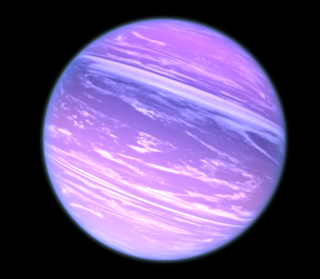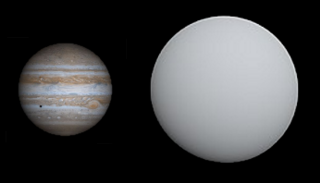Related Research Articles
HD 88133 is a yellow star with an orbiting exoplanet in the equatorial constellation of Leo. It has an apparent visual magnitude of 8.01, which is too faint to be visible to the naked eye. With a small telescope it should be easily visible. The distance to this system, as measured through parallax, is 240 light years, but it is slowly drifting closer with a radial velocity of −3.6 km/s.
The Kilodegree Extremely Little Telescope is an astronomical observation system formed by two robotic telescopes that are conducting a survey for transiting exoplanets around bright stars. The project is jointly administered by members of Ohio State University Department of Astronomy, the Vanderbilt University Department of Physics and Astronomy Astronomy Group, the Lehigh University Department of Physics, and the South African Astronomical Observatory (SAAO).

KELT-2Ab is an extrasolar planet that orbits the star KELT-2A approximately 440 light-years away in the constellation of Auriga. It was discovered by the KELT-North survey via the transit method, so both its mass and radius are known quite precisely. As of its discovery KELT-2Ab is the fifth-brightest transiting Hot Jupiter known that has a well constrained mass. This makes the KELT-2A system a promising target for future space- and ground-based follow-up observations to learn about the planet's atmosphere.

KELT-9b is an exoplanet and ultra-hot Jupiter that orbits the late B-type/early A-type star KELT-9, located about 670 light-years from Earth. Detected using the Kilodegree Extremely Little Telescope, the discovery of KELT-9b was announced in 2016. As of June 2017, it is the hottest known exoplanet.
KELT-21b is an extrasolar planet discovered in 2017. It is a hot Jupiter with radius of about 1.586 MJ.
WASP-63 or Kosjenka, also known as CD-38 2551, is a single star with an exoplanetary companion in the southern constellation of Columba. It is too faint to be visible with the naked eye, having an apparent visual magnitude of 11.1. The distance to this system is approximately 942 light-years based on parallax measurements, but it is drifting closer with a radial velocity of −24 km/s.
KELT-1 is a F-type main-sequence star. Its surface temperature is 6518±50 K. It is similar to the Sun in its concentration of heavy elements, with a metallicity Fe/H index of 0.008±0.073, but is much younger at an age of 1.75±0.25 billion years. The star is rotating very rapidly.
HD 77338 is a star with a close orbiting exoplanet companion in the southern constellation of Pyxis. It is too dim to be visible with the naked eye, having an apparent visual magnitude of 8.63. The system is located at a distance of 149 light years, and it is drifting further away with a heliocentric radial velocity of 8.2 km/s.

KELT-10b is an exoplanet orbiting the G-type main-sequence star KELT-10 approximately 618 light-years away in the southern constellation Telescopium. It was discovered using the transit method, and was announced in 2016.
LHS 1815 b is a thick disk exoplanet, discovered in 2020 by TESS. The planet is located outside the galactic plane.

KELT-3b is an extrasolar planet orbiting the F-type main-sequence star KELT-3 690 light years in the zodiac constellation Leo. It was discovered in 2013 by KELT's telescope in Arizona.

KELT-6b is an exoplanet orbiting the F-type subgiant KELT-6 approximately 791 light years away in the northern constellation Coma Berenices. It was discovered in 2013 using the transit method, and was announced in 2014.
KELT-24 is a single star in the constellation Ursa Major at a distance of approximately 316 light-years from Sun. The apparent magnitude of the star is +8.33m. The star's age is estimated to be about 1.6 billion years. As an F-type main-sequence star, it is similar to the Sun, but slightly hotter and more luminous.
HD 93396 is a solitary star located in the equatorial constellation Sextans. It has an apparent magnitude of 8.04, making it readily visible in binoculars, but not to the naked eye. The object is located relatively close at a distance of 326 light-years based on Gaia DR3 parallax measurements, but it is receding with a heliocentric radial velocity of 34.96 km/s. At its current distance, HD 93396's brightness is diminished by an interstellar extinction of 0.17 magnitudes and it has an absolute magnitude of +3.01.

Akshata Krishnamurthy is a space systems engineer working as Science Phase Lead at the NASA Jet Propulsion Laboratory. Born in India, Krishnamurthy has worked on Mars 2020, NISAR, TESS and ASTERIA missions.
References
- 1 2 3 4 5 Pepper, Joshua; Rodriguez, Joseph E.; Collins, Karen A.; Johnson, John Asher; Fulton, Benjamin J.; Howard, Andrew W.; Beatty, Thomas G.; Stassun, Keivan G.; Isaacson, Howard; Colón, Knicole D.; Lund, Michael B.; Kuhn, Rudolf B.; Siverd, Robert J.; Gaudi, B. Scott; Tan, T. G.; Curtis, Ivan; Stockdale, Christopher; Mawet, Dimitri; Bottom, Michael; James, David; Zhou, George; Bayliss, Daniel; Cargile, Phillip; Bieryla, Allyson; Penev, Kaloyan; Latham, David W.; Labadie-Bartz, Jonathan; Kielkopf, John; Eastman, Jason D.; et al. (2017). "KELT-11b: A Highly Inflated Sub-Saturn Exoplanet Transiting the V = 8 Subgiant HD 93396". The Astronomical Journal. 153 (5): 215. arXiv: 1607.01755v1 . Bibcode:2017AJ....153..215P. doi: 10.3847/1538-3881/aa6572 . S2CID 30219578.
- ↑ Colón, Knicole D.; Kreidberg, Laura; Line, Michael; Welbanks, Luis; Madhusudhan, Nikku; Beatty, Thomas; Tamburo, Patrick; Stevenson, Kevin B.; Mandell, Avi; Rodriguez, Joseph E.; Barclay, Thomas; Lopez, Eric D.; Stassun, Keivan G.; Angerhausen, Daniel; Fortney, Jonathan J.; James, David J.; Pepper, Joshua; Ahlers, John P.; Plavchan, Peter; Awiphan, Supachai; Kotnik, Cliff; McLeod, Kim K.; Murawski, Gabriel; Chotani, Heena; LeBrun, Danny; Matzko, William; Rea, David; Vidaurri, Monica; Webster, Scott; et al. (2020). "An Unusual Transmission Spectrum for the Sub-Saturn KELT-11b Suggestive of a Subsolar Water Abundance". The Astronomical Journal. 160 (6): 280. arXiv: 2005.05153 . Bibcode:2020AJ....160..280C. doi: 10.3847/1538-3881/abc1e9 . S2CID 218581200.
- ↑ Changeat, Q.; Edwards, B.; Al-Refaie, A. F.; Morvan, M.; Tsiaras, A.; Waldmann, I. P.; Tinetti, G. (2020), "KELT-11 b: Abundances of Water and Constraints on Carbon-bearing Molecules from the Hubble Transmission Spectrum", The Astronomical Journal, 160 (6): 260, arXiv: 2010.01310 , Bibcode:2020AJ....160..260C, doi: 10.3847/1538-3881/abbe12 , S2CID 222132941


